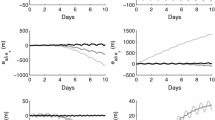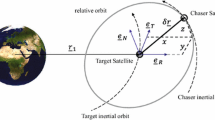Abstract
Using the reference orbital element approach, the precise governing equations for the relative motion of formation flight are formulated. A number of ideal formations with respect to an elliptic orbit can be designed based on the relative motion analysis from the equations. The features of the oscillating reference orbital elements are studied by using the perturbation theory. The changes in the relative orbit under perturbation are divided into three categories, termed scale enlargement, drift and distortion respectively. By properly choosing the initial mean orbital elements for the leader and follower satellites, the deviations from originally regular formation orbit caused by the perturbation can be suppressed. Thereby the natural formation is set up. It behaves either like non-disturbed or need little control to maintain. The presented reference orbital element approach highlights the kinematics properties of the relative motion and is convenient to incorporate the results of perturbation analysis on orbital elements. This method of formation design has advantages over other methods in seeking natural formation and in initializing formation.
Similar content being viewed by others
References
Sabol, C., Burns, R., McLaughlin, C.A.: Satellite formation flying design and evolution. Advances in the Astronautical Sciences 102, Part 1, 265–283 (1999)
Inalhan, G., How, J.P.: Relative dynamics & control of spacecraft formations in eccentric orbits. In: AIAA Guidance, Navigation and Control Conference and Exhibit, Denver, CO, August 2000, AIAA 2000–4433
Baoyin, H.X., LI, J.F., GAO, Y.F.: Dynamical behaviors and relative trajectories of the spacecraft formation. Aerospace Science and Technology, 6, 295–301 (2002)
Schaub, H., Alfriend, K.T.: J 2 Invariant reference orbits for spacecraft formations. In: Flight Mechanics Symposium, Goddard Space Flight Center, Greenbelt, Maryland, May 18-20 1999. Paper No. 11
Wang, H.M., Li, J.F., Yang, W.: Orbit design for satellites in formation flight using reference orbital elements. Engineering Mechanics, 2006, 3 (in Chinese) (in press)
Wang, H.M., Yang, W., Li, J.F.: Design on ideal satellites formation configuration with an elliptic reference orbit. J. Tsinghua Univ., 2006, 2 (in Chinese) (in press)
Schaub, H., Vadali, S.R., Alfriend, K.T.: Spacecraft formation flying control using mean orbit elements. In: AAS/AIAA Astrodynamics Specialist Conference, Girdwood, Alaska, Aug.16–19 1999, Paper No. 99–310
Xiao, F.: Orbital Perturbation Theory of Satellites. National University of Defense Technology Publishing House, Beijing, 1997 (in Chinese)
Brouwer, D.: Solution of the problem of artificial satellite theory without drag. The Astronomical Journal 64, 378–397 (1959)
Author information
Authors and Affiliations
Corresponding author
Rights and permissions
About this article
Cite this article
Wang, H., Yang, W. & Li, J. Solution set on the natural satellite formation orbits under first-order earth's non-spherical perturbation. ACTA MECH SINICA 21, 503–510 (2005). https://doi.org/10.1007/s10409-005-0063-5
Received:
Revised:
Accepted:
Published:
Issue Date:
DOI: https://doi.org/10.1007/s10409-005-0063-5




